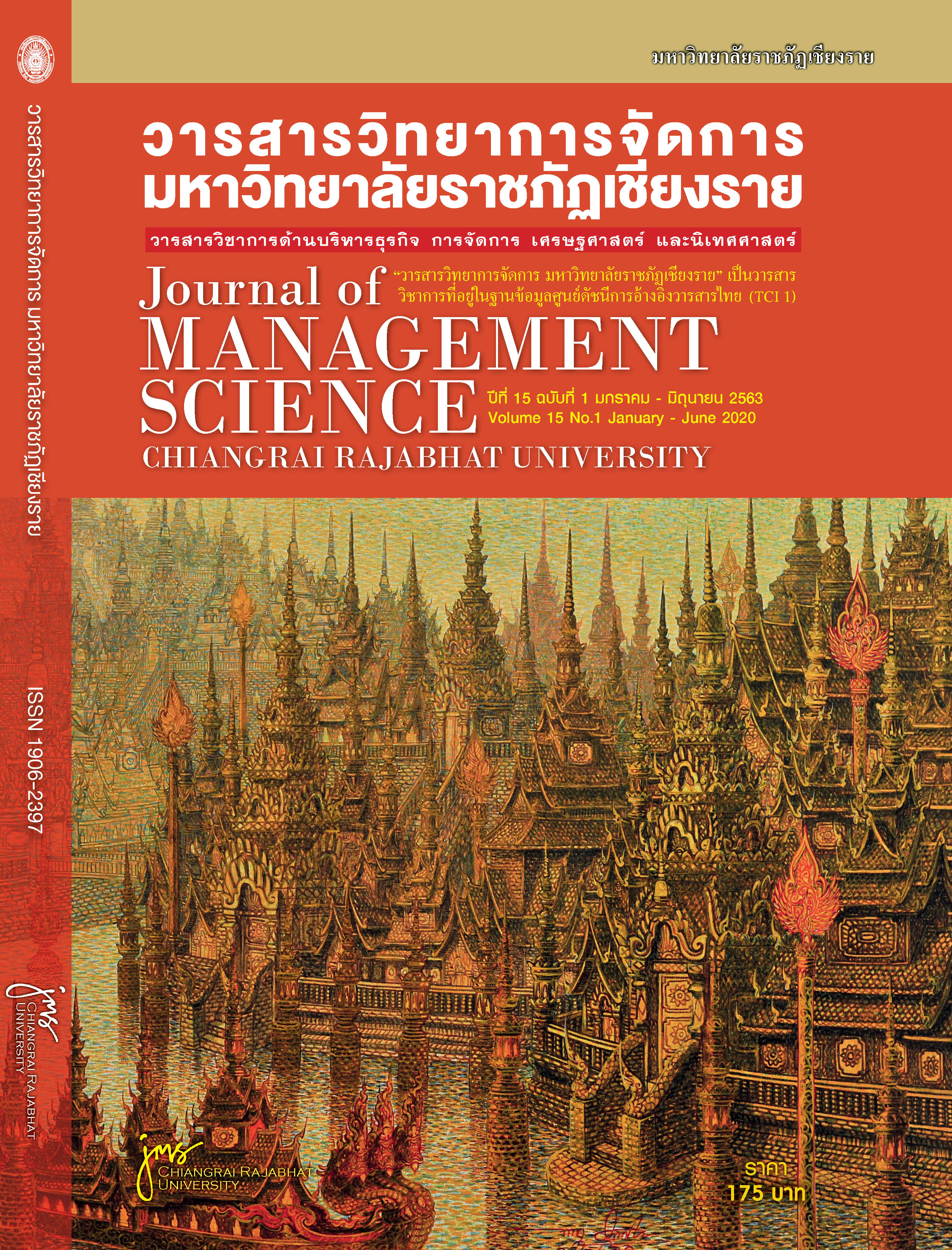อิทธิพลเชิงโครงสร้างของปัจจัยความได้เปรียบทางการแข่งขันของวิสาหกิจขนาดกลางและขนาดย่อมในกลุ่มธุรกิจบริการ เขตภาคเหนือตอนบน ประเทศไทย
Main Article Content
บทคัดย่อ
การวิจัยในครั้งนี้ มีวัตถุประสงค์เพื่อศึกษาอิทธิพลเชิงโครงสร้างของปัจจัยความได้เปรียบทางการแข่งขัน ที่มีต่อความสำเร็จในการดำเนินงานของวิสาหกิจขนาดกลางและขนาดย่อมในกลุ่มธุรกิจบริการ เขตภาคเหนือตอนบน ประเทศไทย เป็นการวิจัยเชิงสำรวจโดยใช้วิธีการศึกษาวิจัยเชิงปริมาณ กลุ่มตัวอย่างที่ใช้ในการวิจัย คือ ผู้ประกอบธุรกิจวิสาหกิจขนาดกลางและขนาดย่อมในกลุ่มธุรกิจบริการ เขตภาคเหนือตอนบน ประเทศไทย จำนวน 369 คน ใช้วิธีการสุ่มตัวอย่างแบบหลายขั้นตอน เครื่องมือที่ใช้ในการวิจัยเป็นแบบสอบถาม วิเคราะห์ข้อมูลโดยการหาค่าสถิติพื้นฐาน และการวิเคราะห์องค์ประกอบเชิงยืนยัน เพื่อทดสอบความสอดคล้องของโมเดลสมการโครงสร้างของปัจจัยความได้เปรียบทางการแข่งขันของวิสาหกิจขนาดกลางและขนาดย่อมในกลุ่มธุรกิจบริการกับข้อมูลเชิงประจักษ์ ผลการศึกษาพบว่า ปัจจัยความได้เปรียบทางการแข่งขันของวิสาหกิจขนาดกลางและขนาดย่อมในกลุ่มธุรกิจบริการ จำนวน 5 ปัจจัย เรียงลำดับตามน้ำหนักองค์ประกอบจากมากไปน้อย ได้แก่ 1) ด้านการตลาด (.916) 2) ด้านบุคลากร (.869) 3) ด้านเทคโนโลยี (.857) 4) ด้านการบริหารจัดการ (.823) และ 5) ด้านต้นทุน (.765) ตามลำดับ ผลการทดสอบความสอดคล้องของโมเดลโครงสร้างปัจจัยความได้เปรียบทางการแข่งขันของวิสาหกิจขนาดกลางและขนาดย่อมในกลุ่มธุรกิจบริการ โดยใช้ ค่าไค-สแควร์ ค่าดัชนีวัดระดับความกลมกลืน และค่าดัชนีวัดระดับความกลมกลืนที่ปรับแก้แล้ว พบว่า โมเดลมีความสอดคล้องกับข้อมูลเชิงประจักษ์อย่างมีนัยสำคัญทางสถิติ ค่า p มีค่าเท่ากับ .062 ค่า χ2/df เท่ากับ 1.174 ค่า CFI เท่ากับ .997 ค่า TLI เท่ากับ .994 ค่า RMSEA เท่ากับ .015 และค่า HOELTER เท่ากับ 751 ผลการวิจัยจึงยืนยันความสัมพันธ์เชิงโครงสร้างของปัจจัยความได้เปรียบทางการแข่งขันของวิสาหกิจขนาดกลางและขนาดย่อมในกลุ่มธุรกิจบริการเป็นอย่างดี
Article Details
ทัศนะและข้อคิดเห็นของบทความที่ปรากฏในวารสารฉบับนี้เป็นของผู้เขียนแต่ละท่าน ไม่ถือว่าเป็นทัศนะและความรับผิดชอบของกองบรรณาธิการ
เอกสารอ้างอิง
Anderson, J. C. & Gerbing, D. W. (1988). Structural equation modeling in practice: A review and recommended two-step approach. Psychological Bulletin. 103. 411-423.
Amit, R. & Schoemaker, P. J. (1993). Strategic assets and organizational rent. Strategic management journal. 14(1). 33-46.
Buijink, W., Maijoor, S., Van Witteloostuijn, A. & Zinken, M. (1993). The evolution of the structure of the Dutch audit industry: An empirical study. Unpublished research memorandum. University of Limburg, Maastricht.
Deming, W. E. (1981). Improvement of quality and productivity through action by management. National productivity review. 1(1). 12-22.
Flippo, E.B. (1971). Principles of Personnel Management. New York: Mcgraw Hill Book. 4–7.
Iuliana, C., Sorin, M. D. & Razvan, D. (2008). The competitive advantages of small and medium enterprises. Strategic Management Journal. 811-816.
Jeeramat Pongnarat. (2016). The Procreation of Competitive Advantage Strategies for Entertainment Enterprise in Chiang Mai. Master of Business Administration in Business Administration, Maejo University. Retrieved January 11, 2017. from https://webpac.library.mju. ac.th:8080/mm/fulltext/
thesis/2560/pongnarat_jeeramat/fulltext.pdf. (In Thai)
Kanchanopast Supattra. (2011). The Factors Influencing successful Implementation of E- Commerce to Create Competitive Advantage, within SME Businesses. Suan Sunandha Rajabhat University. Retrieved June 11, 2011. from https://www.ssruir.ssru.ac.th/bitstream/ssruir/456/1/045-54.pdf. (In Thai)
Kettl, D. F. & Fosler, J. W. (2005). The Politics of the Administrative Process. (3rd ed.). Washington D.C. : CQ Press.
Kotler, Philip. (1999). Kotler on Marketing: How to Create, Win, and Dominate Markets. New York, NY : Free Press.
Meksuwan Atchara. (2017). The Competitive Advantage of Agricultural Processing Industry SMEs Entrepreneurs in Upper Northern Region, Thailand. Journal of Yala Rajabhat University. 12(Special Issue). 13-26. (In Thai)
Mondy, R. W., Noe, R. M. & Premeaux, S. R. (1999). 7th Ed. Human Resource Management. UpperSaddle River, NJ : Simon & Schuster.
Munir, A., Lim, M. K. & Knight, L. (2011). Sustaining competitive advantage in SMEs. Procedia- Social and Behavioral Sciences. 25. 408-412.
Office of Small & Medium Enterprise Promotion. (2016). The Study of Supporting Approach for SMEs high Growth Sectrors. Retrieved June 20, 2016. from https://www. sme.go.th/th/images/data/SR/
ownload/2014/07july
Office of Small & Medium Enterprise Promotion. (2017). The 2016 Situation report of SMEs. Retrieved August 1, 2017. from https://www.sme .go. th/th/ images/ data/SR/download/2015/report_year
Peters, T. J. & Waterman, Robert. H. Jr. (1982). Search of Excellence. (New York : Happer and Row).
Porter, M. E. (1990). The Competitive Advantage of Nations. New York : Free Press.
Prakthayanon Suchart. (2013). Creation of Competitive Advantages of Small and Medium-Sized Business of the Vehicle Industry in Thailand. ACADEMIC JOURNAL BANGKOKTHONBURI UNIVERSITY. 2(1). 102-110. (In Thai)
Tornatzky, L. G., Fleischer, M. & Chakrabarti, A. K. (1990). The processes of technological innovation. Retrieved October 10, 2017. from https://is.theorizeit.org/ Technology-organization-environment_framework
Torudom Rungnapha. (2013). Key Success Factors of Small and Medium Entrepreneurs in Agricultural Industry the Case study of Chacherngsao. Rajamangala University of Technology Thanyaburi. Retrieved June 11, 2016. from https://www.research.rmutt.ac .th/?p=2150. (In Thai)
Wickham, PA. (2001). Strategic Entrepreneurship: A Decision-Making Approach to New Venture Creation and Management. (2nd ed.) Harlow : Pearson Education.


